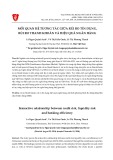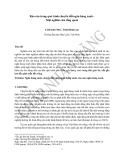
http://www.iaeme.com/IJM/index.asp 181 editor@iaeme.com
International Journal of Management (IJM)
Volume 7, Issue 7, November–December 2016, pp.181–190, Article ID: IJM_07_07_019
Available online at
http://www.iaeme.com/ijm/issues.asp?JType=IJM&VType=7&IType=7
Journal Impact Factor (2016): 8.1920 (Calculated by GISI) www.jifactor.com
ISSN Print: 0976-6502 and ISSN Online: 0976-6510
© IAEME Publication
DEVELOPMENT OF PARTICIPATION BANKS AND
EVALUATION OF PARTICIPATION BANKS IN TERMS
OF PERFORMANCE: AN APPLICATION IN TURKEY
AND MALAYSIA
Eda ORUÇ ERDOĞAN
Assistant Professor, Akdeniz University, Business Administration Department, Turkey
Abdullahi Mohamed NUR
Phd Student, Akdeniz University, Business Administration Department, Turkey
ABSTRACT
Banks fall within the financial institutions, which play an important role in financial system and
effect national economies. Stability of economy is basically based on performances of banks. As
traditional banks in financial system are such banks that collect bank deposits or a specified rate of
interest from depositors with fund surplus and extend them to those requesting funds in exchange of
specified rate of interest, the most important issue differentiating participation banking from
traditional banking is that they provide with share instead of interest. Participation banks, which
operate based on interest-free basis, become more effective in financial systems day by day.
Accordingly, it is an important issue to determine the performances of participation banks.
Performances of participation banks in the Turkish financial system and performances of
participation banks in Malaysia are evaluated within this study, between 2000 and 2015.
Relationship between profitability of participation banks and macroeconomic characteristics and
indicators peculiar to banks operating in Turkey and Malaysia are examined.
According to the results obtained, it is concluded that capital adequacy, size of bank,
management quality and macroeconomic indicators are effective in the Turkish participation
banks; management quality, income quality, size of bank, liquidity and macroeconomic indicators
are effective in the Malaysian participation banks.
Key words: Participation Banks, Financial Ratios, Multiple Regression Analysis
Cite this Article: Eda ORUÇ ERDOĞAN and Abdullahi Mohamed NUR. Development of
Participation Banks and Evaluation of Participation Banks In Terms of Performance: An
Application In Turkey and Malaysia. International Journal of Management, 7(7), 2016, pp. 181–
190.http://www.iaeme.com/IJM/issues.asp?JType=IJM&VType=7&IType=7

Eda ORUÇ ERDOĞAN and Abdullahi Mohamed NUR
http://www.iaeme.com/IJM/index.asp 182 editor@iaeme.com
INTRODUCTION
Interest-free banking, which was started to feel its presence at the end of 1960's in the world, found field of
activity in many countries by drawing attention with utilization of passive funds and its impact on
development. Participation banks came to the fore at the beginning of 1980's and it has approximately 25
years of experience (Eskici, 2007).
Participation banks, which became popular in the name of "interest-free banking", emerged as a result of
accumulation of substantial savings and utilization need of these savings, mostly in the Gulf countries
where Muslim population live. We can find Participation Banks in many countries around the world,
which can be incorporated as partnerships and autonomous establishments as a result of "interest-free
banking" initiative led by the Islamic development Bank. This kind of institutions exists in countries,
where Muslim communities or minorities live.
Participation Banks play a supportive role for real sector, preventing underground economy and
increasing employment and competition with original methods to include passive funds to financial and
banking system by filling this gap with interest-free instruments.
By the economic crisis in 2008 which affected the whole world economies, some researches have
started for new systems in capital markets, financial services and products. One of the alternative systems,
which was seen as a way out of crisis, is "Islamic Finance".
The goal of this study is to search how financial performance, factors belonging to the bank and
macroeconomic factors of Participation Banks operating in Turkey and Malaysia affect their profitability.
This study uses quantitative research methodology. For evaluating the financial performances of such
banks, financial ratio scale will be applied.
1. AN OVER VIEW ON PARTICIPATION BANKING
The willing of Muslims in the world to maintain their financial activities in accordance with Islamic rules
had been the leading motive of emergence of Islamic banking as the most important factor of Islamic
finance concept and Islamic financial sector. In general, Participation Banks are institutions providing that
people utilize their under-the-mattress savings or domestic and overseas savings else than money (gold,
foreign currency etc.) for participating in profit/loss participation (Ayrıçay, Ada and Kaya, 2013).
Islamic finance concept is a system that all financial activities and transactions are done in accordance
with Islamic rules. Islamic finance, which is considered as an alternative to modern financial understanding
since interest is deemed as forbidden by religion, has developed as an alternative field in global finance
markets in consideration of recent developments. In this regard, all methods of Islamic finance are based
on principles of transactions with no interest and Islamic business ethics (Tekbaş, 2013).
Participation banks with the principle of Islamic banking (interest-free banking) play an effective role
in forming a market where interest does not exist and commerce methods, which are not against Islamic
rules, have control over (Özulucan and Deran, 2009). In other words, essential objective of Participation
banking is to bring in foreign capital and financial values, which cannot be added to economy for several
reasons, by getting out of them from under-the-mattress with the principles of interest-free finance.
At the present time, participation banks aimed at providing with a variety of financial instruments,
which are effective in all developed countries' financial markets, and at providing with alternative
institutions and tools to uni-dimensional traditional banking system, and at giving various banking services
in accordance with Islamic principles. And they achieved that goal albeit partially (Özulucan and Deran,
2009)

Development of Participation Banks and Evaluation of Participation Banks In Terms of Performance: An
Application In Turkey and Malaysia
http://www.iaeme.com/IJM/index.asp 183 editor@iaeme.com
2. LITERATURE REVIEW ABOUT PERFORMANCE EVALUATION OF
PARTICIPATION BANKS
When literature about Participation Banking is reviewed, it is seen that some of the studies evaluate the
performances of Participation Banks, whereas some compare Participation Banks and traditional banking
activities or performances.
Iqbal (2001) compared the performances of 12 Islamic and traditional banks form nine countries (Saudi
Arabia, Kuwait, Bahrain, Egypt, Jordan, United Arab Emirates, Bangladesh, Malaysia and Turkey). He
examined these banks in terms of profitability, liquidity, risk and capital adequacy in his study, between
1990 and 1998. At the end of his study, he concluded that almost every year, Islamic banks are more
productive in terms of liquidity and profitability.
Loghod (2010) compared the performances of Islamic and traditional banks, which operate in countries
having members in Cooperation Council for the Arab States of the Gulf. He found out that there is not a
meaningful difference between the performances of Islamic banks and traditional banks. However, it is
concluded that credit risk of participation banks are higher than those of traditional banks.
Kader and Asarpota (2007) evaluated the performances of Islamic and traditional banks in United Arab
Emirates comparatively. At the end of his study, he concluded that for the years of 2006-2007 liquidity and
profitability of Islamic banks are higher than those of traditional banks.
Ansari and Rehman (2010) compared Islamic banks and traditional banks in Pakistan in terms of
profitability, liquidity, credit risk, asset structure. At the end of their study, in which they benefited from
data of 2007-2010, they concluded that Islamic banks are less effective than traditional banks. In the study
conducted by Aras ve Öztürk (2011), fund allocation shares of participation banks in Turkey were
evaluated. It was seen that the fund utilization rate based on profit/loss is low for the periods examined.
Bağcı (2013) examined performances of participation banks and conventional banks based on profitability.
According to the results, it was concluded that participation banks are more profitable than conventional
banks.
Jaffar and Manarvi (2011) examined the performances of Islamic and traditional banks in Pakistan,
comparatively by using CAMEL analysis method. As a result of the study, they concluded that Islamic
banks perform better in terms of liquidity and capital adequacy, on the other hand traditional banks
perform better in terms of profitability.
Parlakkaya and Çürük (2011) tried to determine whether a distinction can be drawn between
participation banks and traditional banks operating in Turkey based on their financial characteristics. As a
result of the research, they concluded that participation banks have a higher profitability and risk than
those of traditional banks. Nonetheless, they concluded that asset quality indicators and liquidity values are
in favor of traditional banks.
Esmer and Bağcı (2016) evaluated the financial performance of participated banks. They analysed the
2005-2014 period. And they used several financial indicators to investigated the performance of banks.
Onour and Abdalla (2011) used the Data Envelopment Analysis technique to investigate the
performance of Islamic banks in Sudan during the 2007-2008 period. As a result of studying on 12 Islamic
banks with private capital and public funds, it has been revealed that bank size is an important factor for
scale efficiency, as there is no restriction of ownership, management and scale efficiency. Safiullah (2010)
evaluated the financial performance of the participation banks for Bangladesh in terms of profitability
ratios, liquidity ratios, productivity ratios and economic conditions. According to the results obtained, it
was determined that participation banks were more efficient than commercial banks in terms of
profitability and liquidity. Moin (2008) compared Pakistan's participation banks with commercial banks
and in terms of profitability, liquidity, risk and efficiency and it was concluded that participation banks are
less profitable and less efficient compared to commercial banks.

Eda ORUÇ ERDOĞAN and Abdullahi Mohamed NUR
http://www.iaeme.com/IJM/index.asp 184 editor@iaeme.com
Samad (2004) examined the performances of Islamic and traditional commercial banks comparatively
operating in Bahrain between 1991 and 2001. According to the results of research, he concluded that there
is no any important difference between Islamic and traditional banks in terms of profitability and liquidity.
Siraj and Pillai (2012) examined the performances of Islamic banks and traditional banks operating in
the Gulf Arab States. They concluded that liquidity, deposit increase and growth rate in profitability of
Islamic banks are faster. Besides, they concluded that leverage ratio of Islamic banks are higher than those
of traditional banks.
Parlakkaya and Çürük (2011) examined 24 traditional banks and 4 participation banks operating in Turkey between 2005
and 2008. According to the research results, profitability and liquidity ratios can be used as a distinctive factor between two
types of banks.
Buğan (2015) aimed at identifying whether participation banks use their sources more effectively
compared to traditional banks in his study. Accordingly, activity performances of deposit banks and
participation banks operating in Turkey between 2006 and 2012 are measured with the data envelopment
analysis. As a result of this analysis, it is concluded that participation bans use their sources more
effectively compared to conventional banks.
Usman and Khan (2012) evaluated the performances of Islamic and traditional banks in Pakistan
comparatively. As a result of the analysis, it is concluded that Islamic banks have a higher growth rate and
profitability than those of traditional banks. In addition, writers concluded that liquidity levels of Islamic
banks are higher than those of traditional banks.
Sakarya and Kaya (2013) try to determine in which fields participation banks differentiate, by
analyzing deposit banks and participation banks operating in Turkey, in their study. As a result of the
study, including the data between 2005 and 2012, participation banks do not differentiate from other banks
in terms of efficiency and profitability as they focus on financial intermediation activities by working with
higher resources.
3. DATA AND METHOD
Variables of banks, which are compiled to be evaluated in the analysis, were obtained from activity reports
of Participation Banks and financial statement tables reached from Bankscope. Macroeconomic variables
are gathered from the Global Finance website.
12 banks are evaluated in this research. While 8 of these banks are participation banks operating in
Malaysia, 4 of them are participation banks operating in Turkey. Banks included in the analysis are as
mentioned in table 1. Evaluation period is concluded as 2000-2015.
Table 11 The Banks in Analysis
No. Participation Banks in Malaysia Participation Banks in Turkey
1 Affin islamic bank Albaraka Türk Katılım Bankası
2 Bank islam malaysia Bank Asya Katılım
3 Hong Leong bank berhad Küveyt Türk Bank
4 RHB islamic bank berhad Türkiye Finans
5 Ambank islamic berhad
6 CIM islamic bank
7 Public islamic bank
8 SCSB Berhad

Development of Participation Banks and Evaluation of Participation Banks In Terms of Performance: An
Application In Turkey and Malaysia
http://www.iaeme.com/IJM/index.asp 185 editor@iaeme.com
Dependent variables expressing the performances of banks are return on assets (ROA) and return on
equity (ROE). While independent variables specific to banks are capital adequacy, management quality,
income quality, liquidity and size of bank; independent variables related to macroeconomic indicators are
growth rate of gross domestic product, average annual inflation rate and dummy variable, which represents
the periods with economic difficulty. Calculations related to used variables are mentioned in Table 2.
Table 2 The Measurement Used in the Study and Explanatory Indicators
Dependent Variables Calculating
Return on Assets Net Profit / Total Assets (ROA)
Return on Equity Net Profit/ Total Equity (ROE)
Independent Variables Calculating
Capital Adequacy Total Equity/Total Assets (CA)
Management Quality Credit/Deposits (MQ)
Return Quality Total Expenses/Total Income (RQ)
Liquidity Liquid Assets/ Total Assets (LI)
Bank Size Natural Logarithm of Total Assets (BS)
Macroeconomic Variables Calculating
Gross National Product Growth of Gross Domestic Product (GDP)
Inflation Rate Average Annual Inflation Rate (ENFO)
Dummy Variable Crisis Periods (1), None Crisis Periods (0) (D)
Below mentioned regression models will be used as determinants of profitability for testing in this study.
ROA
=
β
0
+ β
1
(CA
)
+ β
2
(MQ) + β
3
(RQ
)
+ β
4
(Lİ) + β
5
(BS) + β
6
(GDP) + β
7
(IR) + β
8
(D) + ε (Model1)
ROE
=
β
0
+ β
1
(CA
)
+ β
2
(MQ) + β
3
(RQ
)
+ β
4
(LI) + β
5
(BS) + β
6
(GDP) + β
7
(IR) + β
8
(D) + ε (Model2)
4. FINDINGS
Findings obtained as a result of the models, which were formed to compare the performances of the
Malaysian participation Banks operating in Malaysia and performances of the Turkish participation Banks
operating in Turkey, are mentioned in Table 3 and Table 4. Hereunder, when variables effecting the
performances of participation banks operating in each of the countries are examined, it is seen that
meaningful variables for the Turkish participation banks in model 1 are CA, BS, GDP, IR, D; for the
Malaysian participation banks are MQ, Lİ, BS, GDP and IR.
When relations are evaluated, CA, BS and GNP effects the profitability of the Turkish participation
banks positively; ER and D effect the profitability of banks negatively. In the Malaysian participation
banks, GDP effects the profitability of banks positively; MQ, Lİ, BS and IR effect profitability of banks
negatively.


























